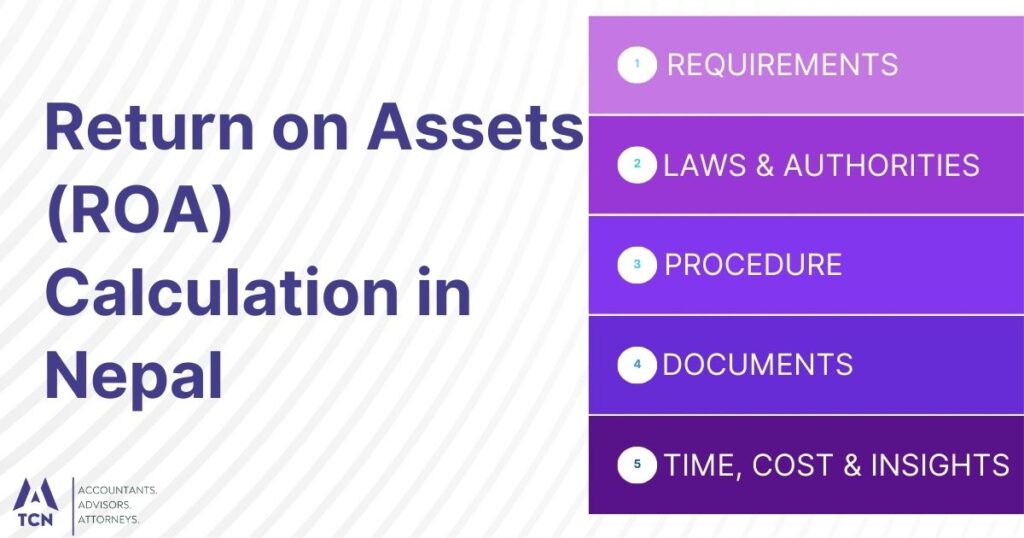Return on Assets (ROA) is a financial ratio that measures a company’s profitability in relation to its total assets. It indicates how efficiently a company utilizes its assets to generate profits. ROA is expressed as a percentage and calculated by dividing net income by total assets. This ratio helps investors, managers, and analysts assess a company’s financial performance and operational efficiency.
How is ROA calculated in Nepal?
In Nepal, ROA is calculated using the following formula:
ROA = (Net Income / Total Assets) x 100
Net Income is obtained from the company’s income statement, while Total Assets are found on the balance sheet. Nepali companies typically use the average total assets for the period to account for fluctuations throughout the year.
Why is ROA important for businesses?
ROA is crucial for businesses in Nepal for several reasons:
- Performance evaluation: It helps assess how effectively a company uses its assets to generate profits.
- Benchmarking: Allows comparison with industry peers and competitors.
- Investment decisions: Assists investors in evaluating potential investments.
- Management efficiency: Indicates how well management utilizes company resources.
- Strategic planning: Helps identify areas for improvement in asset utilization.
What financial documents are needed for ROA calculation?
To calculate ROA in Nepal, the following financial documents are required:
- Income Statement
- Balance Sheet
- Cash Flow Statement (for additional context)
- Notes to Financial Statements
Who typically calculates ROA in Nepali companies?
In Nepali companies, ROA is typically calculated by:
- Financial analysts
- Accountants
- Chief Financial Officers (CFOs)
- External auditors
- Investment analysts
What’s considered a good ROA in Nepal?
A good ROA in Nepal varies by industry and company size. Generally, an ROA above 5% is considered acceptable, while an ROA above 10% is deemed excellent. However, these benchmarks may differ based on the specific sector and economic conditions in Nepal.
How often should ROA be calculated?
Nepali companies typically calculate ROA:
- Quarterly
- Semi-annually
- Annually
More frequent calculations provide better insights into performance trends and allow for timely decision-making.
Are there legal requirements for ROA reporting?
In Nepal, there are no specific legal requirements for ROA reporting. However, public companies listed on the Nepal Stock Exchange (NEPSE) must disclose financial ratios, including ROA, in their annual reports as per the Securities Board of Nepal (SEBON) regulations.
Which authorities oversee financial ratio reporting in Nepal?
The following authorities oversee financial ratio reporting in Nepal:
- Securities Board of Nepal (SEBON)
- Nepal Rastra Bank (NRB) for banking and financial institutions
- Office of the Company Registrar
- Nepal Chartered Accountants Association (ICAN)
How does ROA differ from other profitability ratios?
ROA differs from other profitability ratios in the following ways:
- Return on Equity (ROE): ROA considers all assets, while ROE focuses on shareholders’ equity.
- Profit Margin: ROA measures profitability relative to assets, while profit margin relates to sales.
- Return on Capital Employed (ROCE): ROA includes all assets, whereas ROCE considers only capital employed.
Can ROA be negative?
Yes, ROA can be negative when a company incurs a net loss. A negative ROA indicates that the company is not generating profits from its assets and may be experiencing financial difficulties.
What are the limitations of ROA?
ROA has several limitations:
- Industry variations: Difficult to compare across different industries.
- Asset valuation: Affected by accounting methods and depreciation policies.
- Intangible assets: May not accurately reflect the value of intangible assets.
- Short-term focus: Can encourage short-term decision-making at the expense of long-term growth.
- Inflation: May not account for the effects of inflation on asset values.
How does Nepal’s average ROA compare globally?
Nepal’s average ROA varies by industry and is influenced by economic factors. While specific data for Nepal is limited, developing economies often have lower average ROAs compared to developed markets due to infrastructure challenges and economic volatility.
What factors influence ROA in Nepali businesses?
Factors influencing ROA in Nepali businesses include:
- Economic conditions
- Industry competition
- Government policies and regulations
- Infrastructure development
- Access to technology and resources
- Market demand
- Currency fluctuations
- Political stability
How can investors use ROA effectively?
Investors can use ROA effectively by:
- Comparing ROA across companies within the same industry
- Analyzing ROA trends over time
- Considering ROA alongside other financial ratios
- Understanding industry-specific factors affecting ROA
- Assessing ROA in relation to the company’s growth stage
Tax Incentives for Special Industries in Nepal
Custom Duty on Imports in Nepal
Excise Duty Compliance in Nepal
Additional FAQs:
1. Is ROA relevant for all industries?
ROA is relevant for most industries but may be less applicable to certain sectors like financial services, where assets are primarily financial instruments.
2. How does asset valuation affect ROA?
Asset valuation methods can significantly impact ROA. Different depreciation policies or revaluation of assets can alter the total asset value, affecting the ROA calculation.
3. What does a low ROA indicate?
A low ROA may indicate:
- Inefficient asset utilization
- Poor management performance
- Industry-wide challenges
- Economic downturn
- High asset intensity
4. How can businesses improve their ROA?
Businesses can improve their ROA by:
- Increasing net income through revenue growth or cost reduction
- Optimizing asset utilization
- Divesting underperforming assets
- Improving operational efficiency
- Implementing effective working capital management
5. Does company size impact ROA interpretation?
Company size can impact ROA interpretation. Larger companies may have lower ROAs due to higher asset bases, while smaller companies might show higher ROAs but with greater volatility.
6. How does ROA relate to operational efficiency?
ROA directly relates to operational efficiency by measuring how effectively a company uses its assets to generate profits. A higher ROA generally indicates better operational efficiency and asset management.


